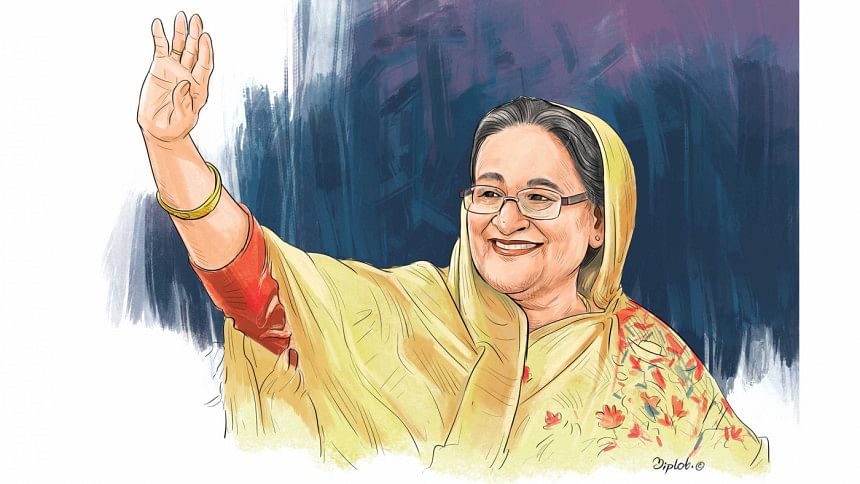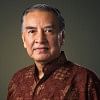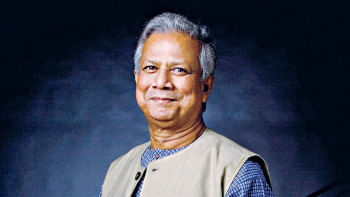Commentary by Mahfuz Anam: Sheikh Hasina’s ‘finest hour’

Borrowing from the title of the second volume of Winston Churchill's six-part history of the Second World War, I would like to term the completion of the Padma Bridge as Prime Minister Sheikh Hasina's "finest hour".
Her ability to see the symbolic importance of defying the World Bank, grasp the real significance of the Padma Bridge to our economy, muster the self-confidence to pull the project through and steadfastly hold on to that confidence through the ups and downs of national and global economy -- especially the pandemic and the Ukraine war -- revealed her extraordinary leadership qualities as never before.
She had exhibited her courageous streak on earlier occasions but the convergence of that courage with astuteness, timing, self-belief, ability to mobilise resources and carry public support through it all provides evidence of an exceptional leader. Her intuitive ability to see that the completion of the Padma Bridge would serve as an immense source of national pride triggering a national "can-do" feeling was the masterstroke of a visionary and futuristic leader. This indeed, we repeat, is her "finest hour".
There are facts and there are symbols in the life of a nation. While facts dominate most of the time, symbols sometimes acquire larger-than-life significance. Such symbols strengthen our self-confidence and prove to the world that we are ready to take on newer challenges, overcome formidable obstacles and be an active partner in humanity's collective efforts to build a better future for all.
The Padma Bridge is such a symbol for Bangladesh. It is a symbol of pride and of self-confidence, of purpose and resoluteness, of decision making and implementation, of vision and transforming that into a reality. With its completion we as a nation and Bangladesh as a country announce to the world that it was not a fortuitous convergence of some positive circumstances but the fruits of our sheer ability that is taking us forward from an underdeveloped to a developing country.
Many countries make their own bridges and with their own resources. But why is it a matter of such significance for us?
First, it breaks down forever our image of a country dependent on "handouts". One cannot imagine the significance of this "breaking down". The greatest harm that colonialism did to all its conquered peoples is sow the seed of inferiority and self-doubt. Through racism -- cultural and intellectual -- and all-out economic exploitation we were made to feel incapable of doing anything. For us, the "inferiority" thesis was further reinforced during the 23 years of Pakistani rule. Coming out of such a mindset remains the biggest challenge for all former colonies, though formal end to colonialism may have come decades ago. In 1971, through an armed liberation struggle, we did declare our independence in the cultural and political sense, but the dependency syndrome persisted in the field of development. A serious blow to the last vestiges of that syndrome may be said to have been dealt through our building of the Padma Bridge.
Second, before the Padma Bridge construction, "donor dictation" could be said to be the name of the game. "Conditionalities" was the key word in any project and strict adherence to those was the reality within which the recipient country -- like Bangladesh -- had to operate. The Padma Bridge marks the most public and direct defiance of a multilateral organisation like the World Bank and through it, of "donor practice" in general.
Bangladesh had never publicly defied a multilateral donor of such stature as the World Bank before, marking a sea change in the relationship between donors and Bangladesh.
The third significant aspect is the confidence that Bangladesh has now acquired of managing mega projects of this scale. This, no doubt, will prove to be of immense value in implementing future projects of a similar scale. The project implementation unit -- consisting of more than 100 local experts supplemented by few from abroad -- played a seminal role. Project Director (PD) Shafiqul Islam, who has headed this project since 2011, deserves special praise for its efficient management and satisfactory implementation.
One clear lesson that comes out of it is that unlike many big projects this was not headed by a bureaucrat but a professional person -- in this case an engineer. The other lesson is that bureaucratic intervention was minimal. Technical experts had the upper hand and not paper-shuffling "know-all" officials. The third lesson is timely decision-making, fund allocation and efficient professional monitoring. If we follow these "lessons" in case of other projects, our rate of implementation will dramatically improve, leading to massive cost savings.
One person whom we must remember and pay respect to on this occasion is Jamilur Reza Chowdhury, popularly known as JRC. He was the chairman of the government's panel of experts and an integral part of this project from the very beginning till his untimely demise in April, 2020. In providing expert guidance and leadership his role was incomparable.
When the bridge faced a near existential threat due to design complexities in 14 crucial mid-river piers, he stunned his peers, including those from the rest of the world, in finding state-of-the-art solutions for them. On this occasion, we pay our heartfelt tribute to this man of extraordinary brilliance and incomparable integrity of character.
The Padma Bridge will not only connect the capital directly with 21 south and southwestern districts but will also contribute to greater connectivity and trade among Asian countries through its linkage with the Asian Highway and Trans-Asian Railway.
With the opening of the Padma Bridge, a new challenge will emerge -- that of making the most efficient use of this magnificent infrastructure. Given its huge cost and enormous maintenance and operational expenses, an optimal use of this massive bridge will have to be made so that we are able to maximise our return from the public money that has been invested in it. For that to happen, our road traffic in general will have to attain a level of efficiency in functionality and operations that we have not attained so far. A whole new level of highway traffic management system will have to be put in place. The sad truth is that our highway traffic management is among the worst, with the road accident rate one of the highest in the world.
Why not use the same mindset that has been so extraordinarily exhibited in making the Padma Bridge a reality, in transforming and modernising our whole road traffic management system? This is the moment to turn our highway management into a modern one as symbolised by the bridge itself. That would indeed be a blessing for all road transport passengers.
Let Padma Bridge stand as the symbol of Bangladesh truly becoming a nation of performance and purpose. Let this bridge represent our comprehensive transition into modernity not only in terms of infrastructure but also in terms of institutions, laws and values. Let the world see Bangladesh as truly graduating into a country of relative prosperity and of freedom, rights and democracy.
That will be the true symbolic value of Padma Bridge.

 For all latest news, follow The Daily Star's Google News channel.
For all latest news, follow The Daily Star's Google News channel. 



Comments